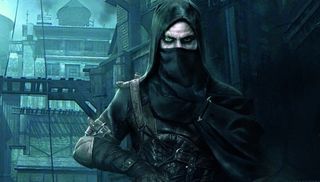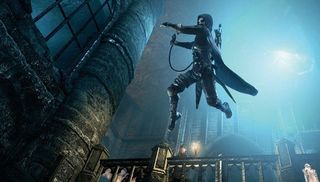Thief preview: Garrett returns to a city of voyeurism and detail, power and character

Originally published in PC Gamer UK issue 252.
"I heard it's like stroking a turtle!” There are probably lots of reasons for not listing a crass line of NPC dialogue as your favourite part of any game, let alone the much-anticipated return of a classic. Still, this is my favourite thing about the new Thief . Partly because it sounds rude, which always goes over well, but also because it captures the spirit of the old games in a way that a thousand hissing water arrows never could – a snatch of conversation caught while cosily enveloped in shadow, the sense of a busy, oblivious world playing out in the light. It's about voyeurism and detail, power and character, and it's a big part of why Thief currently looks like an assured reinvention of a fiercely guarded series.
The studio behind this reinvention, Eidos Montreal, have previous experience with this kind of material. They were founded in 2007 for the specific task of bringing back Deus Ex and Thief, two games associated with an influential creative group that moved between the Looking Glass and Ion Storm studios at the turn of the last century, and are spoken about in the kind of hushed tones normally reserved for great artists or really old people. The games were bound by common ideals: first-person perspective, choice, immersion – and the first reinvention, Deus Ex: Human Revolution, succeeded because it made excellent choices about what to keep from the original and what to update and improve. Now the same process is being applied to Thief.
"As far as Eidos Montreal are concerned, this is the same Garrett as before."
When the team talk about this process, a few things happen. As a group they're aware of the pressures of expectation, but still unusually relaxed and funny – producer Stephane Roy, for instance, opens his introduction by saying his job is “to convince you that I really loved Thief, I'm not just saying it”. The other thing that happens is that everyone says “pillars” a lot, referring to core elements of the first two Thief games in particular (the third game is a more distant creative relation). The arrows are a pillar. The shadow-based stealth is a pillar. Freedom in achieving objectives is a pillar, as is the unnamed city. But the strongest pillar, the one expected to bear the most weight, is the thief himself: Garrett.
Garrett announces himself with a line of monologue that is, under the circumstances, perfectly ambiguous and Garrett-like: “I've been away, but I couldn't tell you where.” The main points being that he's back, and he still talks to himself in the style of a cynical noir hero – handy, since he rarely talks to anyone else (he's the kind of guy who “doesn't have a Facebook page”, says one of the team). As far as Eidos Montreal are concerned, this is the same Garrett as before. “We had carte blanche,” says game director Nicolas Cantin. “We were able to do everything we wanted to do, but at some point we wanted to constrain ourselves within the Thief experience. Our goal was to bring back Garrett, the master thief.”

He looks broadly the same as we last saw in Thief: Deadly Shadows, only with nearly a decade's worth of visual embellishments and detailing. He's an odd shape for a hero: wiry, slightly hunched, bound in leather with piercing eyes staring out from a under his hood. There's an irony somewhere in the character who made not mass-murdering every polygon in sight a first-person possibility, also being the one you'd scream and run from on sight. The added visual sophistication heightens the effect – the scar across Garrett's right eye, for instance, the one that suggests a plot continuity with the very first Thief, looks raw and jagged rather than a leading man's cosmetic accessory. It looks like it really hurt.
The new visual fidelity was key in nudging the team towards Garrett's buckled leather. “With the new power of the platform today, we can really go deep with the shaders,” explains Cantin. “We can almost say 'what type of leather do we want?' and it will be exactly that.” If that gives anyone else flashbacks to mixing seven subtle varieties of brown while painting a Warhammer army, Cantin's team took meticulousness even further. “We made real costumes,” he says, “then lit them to see how [the leather] would react to the lighting.”
The biggest gaming news, reviews and hardware deals
Keep up to date with the most important stories and the best deals, as picked by the PC Gamer team.
"Garrett uses the new gear and technology to build his new bow, which is now more powerful."
Similar steps were taken with Garrett's bow – another of the game's perceived pillars, although this time one open to some changes. Describing the original bow as “kind of weak”, Cantin explains how the specifics of the new game's setting have influenced the updated weapon. “We now have a more industrial setting, a clash of medieval and new industrial. Garrett uses the new gear and technology to build his new bow, which is more powerful than before.”
It's also a bit more self-consciously cool: not just a stick with a string on it, but a folding mechanism that snaps out into a deadly metal instrument. Like the leathers, the bow was physically constructed, this time by a traditional blacksmith in Montreal whose functional design work ended up changing the weapon's final in-game form. (I actually visit the workshop where, as the proud Quebecois artisan turns red hot iron with his bare, blackened hands and speaks earnestly about his mission to save the ancient knowledge of smithing, I decide never to introduce him to my wife.)

Changing the bow is inching into more sensitive territory. Not because the bare aesthetic will be missed, but because the arrows it fires have always been Garrett's principal way of interacting with his environment. Part of the original game's non-lethal sidestep was that arrows were in the main not for killing – they were for snuffing out torches with water, covering noisy floors in deadening moss, and making sounds to distract guards. And so it will be again, the only changes to this particular pillar being an idiomatic refresh of the arrow types (it's now dry ice, rather than water, that extinguishes torches) and, servicing one of the development team's wider concerns, stress-testing the ammo types for plausibility. “We worked really hard on the credibility of those things,” says Cantin, “especially that layer of magic and mysticism. We still have some of those [ammo types], like fire for example, but now balanced so we'll believe in it a little more.”
One of the most interesting elements of the new Thief is an expansion of this pronounced sense of the world's physical properties: the soft carpets, clopping flagstones, almost blanketlike darkness. Now on the borders of the first-person screen are Garrett's hands. They rest on surfaces and obstacles, brush against walls – not always visible, but creeping into view when Garrett presses up against objects, giving a sense of the fabric and flavour of what the studio are calling a “tactile world”.
"On the left, a thief protests as he's clapped into the stocks, on the right a noosed prisoner is kicked from a first-floor ledge."
In the demo Eidos Montreal have prepared, this tactile world looks like one you wouldn't necessarily want to touch. The introduction to The City, another core returning element, has a sense of BioShock-like parade. Garrett rides a bumpy wooden cart through a portcullis checkpoint, with piles of plague victims stacked nakedly on the filthy roadside, top hats and iron armour marking the clash of medieval and Victorian, bystanders and guards muttering and arguing as he passes by. There's a sense that The City is happening on cue – on the left, a thief protests as he's clapped into the stocks, on the right a noosed prisoner is kicked from a first-floor ledge and swings lifelessly into place alongside two or three others.
The City is the same place as before, with a different configuration. The Hammerite and Keeper ideologies that dominated the earlier trilogy are all but swept away (at least on the surface – the occasional Hammerite slogan might appear as a brickwork advertisement, and I did glimpse some Keeper glyphs in the demo).
Most Popular

